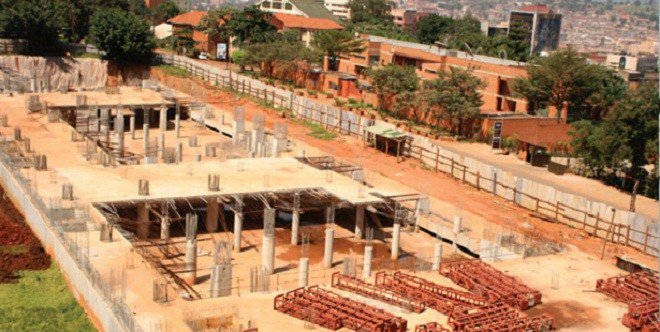
The project cost goes up 57% to Shs410bn
Kampala, Uganda | JULIUS BUSINGE | National Social Security Fund (NSSF) will resume the construction of its Pension Towers on Lumumba Avenue in Kampala before the end of this year. The project was halted nearly seven years ago citing influence peddling in the procurement process.
The Fund’s 32-storey ultra-modern commercial facility will comprise of three towers – the first and second towers – each having 10 storeys while the third tower will have 25 stores, making it the tallest building in Kampala.
The facility will also have four basement levels with parking space for 500 cars and two podium levels for shopping malls, restaurants and conference facilities.
NSSF Managing Director, Richard Byarugaba, told The Independent on August 28 during the Fund’s Annual Members Meeting in Kampala that the Fund has picked a new contractor – China Railway Construction Corporation, replacing Roko Construction Company that did the first phase.
Byarugaba together with the Board Chairperson, Patrick Kaberenge, said the all rightful processes had been followed in securing the new contract to minimise any mistakes.
However, the duo said the cost of the entire project, which is expected to be completed in three years, is likely to go up by 57% to US$110million (Approx. Shs410bn) due changing economic environment.
The construction of Pension Towers started in 2008 but the work was abruptly halted four years later, with the Inspectorate of Government, recommending for a repeat of the tendering process.
This followed IGG’s investigation that claimed that the procurement protocols were violated. The project was initially planned for completion in 2015 at a cost of Shs260bn.
Pension Towers is one of the projects under the Fund’s Real Estate Investments portfolio which constitute 6.6% of its total assets reported at slightly over Shs10trillion as at end of July this year.
Nearly seven year’s loss, gain
Byarugaba told The Independent that the Fund has lost a lot of time and money but the good news is that a new contractor is now onboard.
He said the Fund had already invested Shs50bn on phase one and that it also lost 10% per annum since 2012, equivalent to Shs35bn.
He, however, insisted that the money will be recovered once the building is completed “because we will try to compute total investment including lost time which will be included as part of cost recovery once the project gets to the market.”
He also said that there have been a lot of revaluation gains.
“The value of land along Lumumba Avenue grows at a rate of 20% per annum and we think that the value of the land then is now perhaps another 30-40% above that when the project stalled,” Byarugaba said.
Kaberenge said the Pension Towers project is expected to yield an annual return of 15% to the Fund.
He also said it is part of the NSSF Board’s plan of revamping all construction projects that had stalled for years including Lubowa and Temangalo.
“We thought if we concentrated on the housing sector, we could make a difference,” Kaberenge said.
Expert opinion
Enock Twinoburyo, an economist (PhD) told The Independent that it is unfortunate the Fund lost money and time and that transparency on this loss is warranted.
“The bigger worry should be with the feasibility of the project and the associated cost over runs,” he said.
He added that the risk for a building of such magnitude will be occupancy given the prevailing conditions of dwindling occupancy rates in the centre of the city.
On corruption and bribery allegations, Twinoburyo said, corruption of political nature is difficult to deal with especially when it is entangled with administrative networks – what the IGG calls syndicate corruption.
“There are weaknesses of corruption tacking across the entire cycle of accountability starting from budgeting, execution, audit and its oversight,” he said adding, “The remedy here must come from the top.”
Asked on what NSSF should do to maximise the gains from the project, Twinoburyo said, the costing structure should be reflective of the evolving market dynamics. He said the costing should not be exorbitant but able to meet costs and mark up for savers.
For such projects, he said, NSSF should already have started with client management by sharing information with potential clients.
Similarly, Samuel Mabala, an urban expert and acting director for housing at the Ministry of Lands, Housing and Urban Development, told The Independent on Sept.07 that for NSSF to maximise the gains from the project, it will have to be driven by current pricing of projects located in the same area.
He also said that commercial structures that are beyond five levels high are not attractive to most tenants unless one is considering specialized offers for apartments and condominiums.
 The Independent Uganda: You get the Truth we Pay the Price
The Independent Uganda: You get the Truth we Pay the Price



